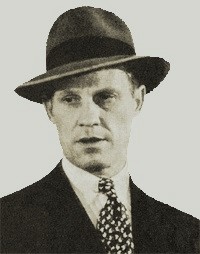
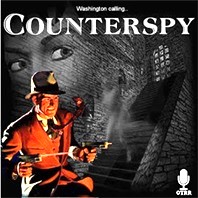 David Harding, Counter-Spy (1942-57) aired “The Case of the Mile High Murders” on April 11, 1950 as one of its estimated 850 broadcasts, of which only approximately 75 still exist.
David Harding, Counter-Spy (1942-57) aired “The Case of the Mile High Murders” on April 11, 1950 as one of its estimated 850 broadcasts, of which only approximately 75 still exist.
We showcased our first episode of this fine program in March of 2023, a year ago, and then the only other episode in September of last year. The creative genius behind Counter-Spy (retitled in 1946 to David Harding, Counter-Spy at the insistence of a new sponsor) was Phillips H. Lord (1902-1975, photo below left). Lord was highly respected in radio circles, having produced such popular programs as Gang Busters (1935-57), Mr. District Attorney (1939-53), and the patriotic series We, the People. When the United States entered world War II following the December 7, 1941 sneak attack on Pearl Harbor, Hawaii, Lord took notice that there were few true espionage programs on the air and decided to rectify the situation by creating Counter-Spy. Many of the stories were based on factual cases Lord had been given access to for use in his previous crime programs, but whose stories were of course dramatized, fictionalized accounts that proved popular with an anxious audience starved and ready for such Good Guys vs. Bad Guys espionage stories with the war at the forefront of their minds. Lord himself was no stranger to spy work, having been a confidential but official agent in secret counter intelligence work for four years before the war broke out.
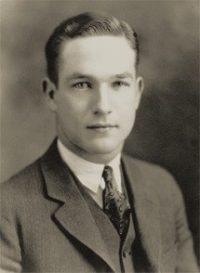
One aspect that brought the war closer to home was that Counter-Spy stories took place in, or close to the United States rather than abroad, with the first few years before the war ended devoted to tales with Lord’s fictional counter-spy, David Harding, and his assistant counter-spy Harry Peters (played by Mandel Kramer) dealing with Germany’s Gestapo and Japan’s Black Dragon spy agencies working clandestinely within the United States. Harding was special in that he was pretty much his own boss, with free-reign over what and how he handled sensitive cases while working with various government departments when his cases happened to cross into their individual jurisdictions. Don MacLaughlin (1906-86, photo top right) was cast as David Harding, his title being loosely interpreted as the head of the United States Counterspies Unit; one might legitimately say he was the Chief Counterspy of this “imaginary” unit. Like Lord, MacLaughlin was no newcomer to radio, having proved himself with his versatility in a number of prior action and dramatic productions. In truth, MacLaughlin had performed in, according to one source, “some 300 roles” since his radio debut in 1935. MacLaughlin secured the permanent role of Harding after the third episode, beating out some 20 others for the top spot. The Lord and MacLaughlin team turned out to be a match made in heaven, for MacLaughlin kept the role for the next 12 years. After the show ended in 1957, MacLaughlin began a new stage in his acting career as, for 30 years, he played attorney Chris Hughes on the daytime soap opera As the World Turns, until his death in 1986. Much interesting background could be added to this necessarily brief introduction to this one of a kind patriotic war time program, but suffice to say it became so popular so quickly that within a year it was so well-received that it took no summer hiatus, and for some of its future programming would be nominated for a Peabody Award and receive “numerous citations from local and civic groups throughout the 1940s.” Aside from a brief period of time (January 1949-August 1950) when it aired twice a week with Pepsi-Cola as the sponsor, David Harding, Counter-Spy was a weekly broadcast throughout its run.
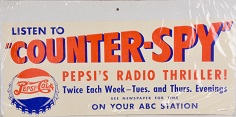
This episode takes David Harding to Cuba to investigate–and hopefully take down and bring to justice–an illegal smuggling ring charging desperate Cuban refugees who can’t afford to escape to the United States legally, an exorbitant fee to fly them to Florida and freedom. But as the title of this story implies, the cartel members flying loads of refugees to the safety of America will stop at nothing to insure their own safety when threatened with capture, including treating human life as an expendable commodity. When dealing with certain social or political themes, listening to radio dramatizations from decades past is a valuable exercise when viewed as historical time capsules, offering perspectives with which to compare how the same themes are treated or dealt with today. Just as was the case at the time of this episode, but today with hundreds of thousands of illegal aliens swarming the United States southern border every year (instead of a few flown into the country by plane as a last resort), and with a wink and a nod of approval from the current political administration whose agenda desires such an influx of possible new voters for purely political reasons, people not from the United States have sought refuge from true oppression for many years from authoritarian countries where freedom is but a theoretical concept, and when we could the people of the United States, as well as official agencies, have aided their escape to this country when and wherever possible, while at the same time thwarting the efforts of those whose only goal was capitalizing on the suffering of their fellow man for the equivalent of a few pieces of silver. “The Case of the Mile High Murders” is one of these stories and is a valuable snapshot of how things were some 75 years ago, and therefore definitely worth a listen.
Play Time: 28:43
{Airing on a Tuesday evening near mid-April of 1950, the neighborhood gang couldn’t wait to hit the nearby newsstand after school the next afternoon, their heads far removed from the confines of any school classroom and with no holiday vacations in sight. In the mood for danger and excitement, they found it in the magazines featured below. Dime Detective (1931-53) was one of the most popular detective pulps of them all. It kept readers glued to its pages for an amazing 274 issues, and in 1950 was a monthly. Other Worlds (1949-53) was Ray Palmer’s companion magazine to his Fate non-fiction magazine that focused on the UFO phenomenon and strange mysteries of the Unexplained. It managed 7 issues in 1950. Popular Detective (1939-53) was noted for the high quality of its stories by many of the field’s top authors. It was a bi-monthly in 1950.}
[Left: Dime Detective, 4/50 – Center: Other Worlds, 3/50 – Right: Popular Detective, 5/50]
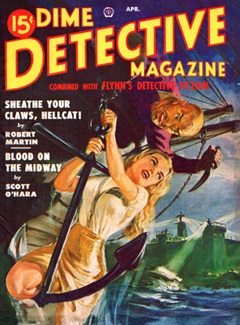
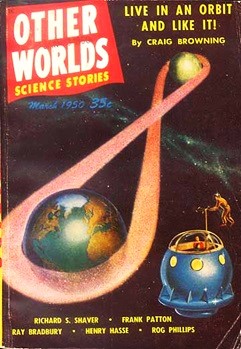
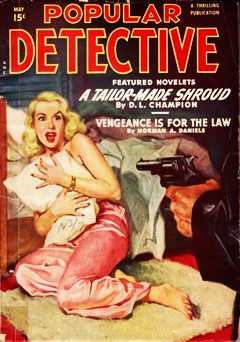
To view the entire list of weekly Old Time Radio episodes at Tangent Online, click here.